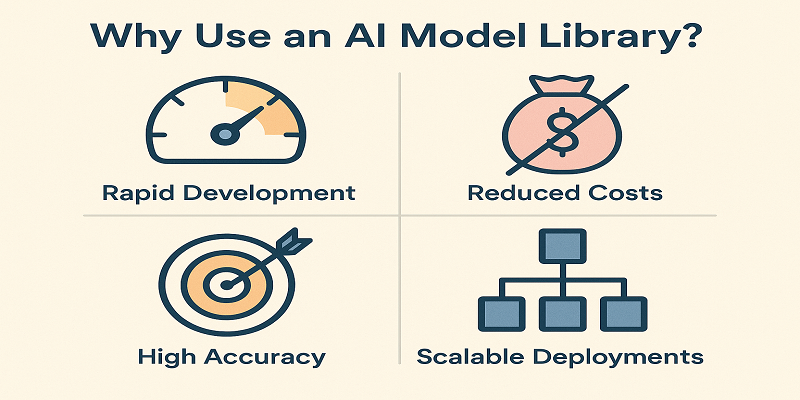 Server
Colocation
Server
Colocation
 CDN
Network
CDN
Network
 Linux Cloud
Hosting
Linux Cloud
Hosting
 VMware Public
Cloud
VMware Public
Cloud
 Multi-Cloud
Hosting
Multi-Cloud
Hosting
 Cloud
Server Hosting
Cloud
Server Hosting
 Kubernetes
Kubernetes
 API Gateway
API Gateway

Artificial Intelligence (AI) is revolutionizing how modern businesses function by automating operations, personalizing customer experiences, and delivering real-time insights from large datasets. However, for beginners or organizations with limited technical resources, a common challenge arises: how to leverage the power of AI without building complex models from scratch. This is where an AI model library proves to be a game-changer. These libraries house a wide range of pre-trained models, making it easier for businesses to implement AI efficiently and affordably.
According to Gartner, by 2026, over 65% of AI-powered applications will rely on pre-trained models, an increase from just 20% in 2021 underscoring the growing shift toward accessible AI solutions. These centralized libraries include models for natural language processing, image classification, fraud detection, and more, enabling startups, developers, and non-AI specialists to deploy intelligent systems without deep technical expertise. In this guide, we’ll explore how to use an AI model library effectively from choosing the right models to integrating them into real-world applications while highlighting how platforms like Cyfuture Cloud are simplifying the AI adoption journey.
Artificial Intelligence (AI) is no longer limited to big tech companies or data science teams with advanced computing power. Thanks to AI model libraries, developers and businesses of all sizes can now integrate pre-trained machine learning (ML) and deep learning (DL) models into their applications without needing to build complex algorithms from scratch. These libraries offer a gateway to faster development, cost-effective AI deployment, and broader innovation across industries.
An AI model library is a centralized repository that houses pre-trained AI models designed to handle tasks such as image classification, natural language processing, speech recognition, fraud detection, and more. These models are trained on expansive datasets like ImageNet (for vision tasks), Common Crawl (for language tasks), and LibriSpeech (for audio recognition), making them robust and reliable for real-world applications.
AI model libraries are typically available through multiple deployment options including cloud hosting platforms, on-premise servers, and hybrid hosting setups. With built-in APIs, developer documentation, and fine-tuning tools, they allow even beginner-level developers to integrate advanced AI functionalities into their products—without the steep learning curve or resource-intensive infrastructure.

Whether you’re a startup building your first intelligent app or an enterprise looking to accelerate innovation, using an AI model library offers distinct advantages:
Pre-trained models significantly reduce development time. You can deploy AI features in a matter of hours instead of spending weeks or months on training.
By leveraging cloud hosting and pre-built infrastructure, you avoid the heavy expenses tied to training models on high-performance servers or GPUs.
Many models in these libraries are battle-tested and fine-tuned for performance, giving you access to best-in-class accuracy from day one.
Whether you want to deploy on the cloud, a private server, or at the edge, AI model libraries are flexible enough to support a variety of use cases and environments.

Start by identifying the specific problem you want to solve. Is it customer sentiment analysis, real-time object detection, or sales forecasting? Your goal will determine the model you choose.
Explore leading AI model libraries that fit your domain:
Hugging Face Transformers – Best for NLP applications
TensorFlow Hub – Great for speech and vision tasks
PyTorch Hub – Versatile models for multiple domains
OpenAI Model Zoo – Advanced generative AI models
Ensure the library you select supports your preferred hosting environment, whether it's the cloud or an on-premise server.
Review model benchmarks such as accuracy, latency, and hardware requirements. Most libraries provide ready-made performance stats to help you evaluate the fit for your use case.
To improve domain-specific results, fine-tune the model with your own data. Many libraries offer support for transfer learning and retraining capabilities.
Use the provided SDKs or APIs to embed the model into your application. Choose your deployment strategy:
Dedicated servers for enterprise-grade control
Scalable cloud platforms for flexible usage
Edge devices for low-latency, real-time processing
Post-deployment, continuously monitor the model’s performance. Use feedback loops to retrain or update the model as needed to maintain accuracy and reliability.
Here are some common applications where AI model libraries can offer immediate value:
Chatbots and virtual assistants
Sentiment analysis and customer feedback classification
Popular models: BERT, GPT-2, RoBERTa
Facial recognition
Object and product detection
Popular models: YOLO, ResNet, EfficientNet
Churn prediction and demand forecasting
Anomaly detection in financial data
Popular models: XGBoost, LightGBM, Prophet
Personalized product suggestions
Content recommendations for streaming platforms
Popular models: Matrix Factorization, Collaborative Filtering
AI is no longer optional, it's essential. With pre-trained AI model libraries, businesses can now innovate faster, reduce costs, and deploy intelligent solutions without complex development.
Cyfuture Cloud makes this easier by offering a secure, scalable platform to access, customize, and deploy AI models—no deep expertise required. Whether it's chatbots, fraud detection, or predictive analytics, Cyfuture Cloud helps you turn ideas into impact, faster.

Let’s talk about the future, and make it happen!
By continuing to use and navigate this website, you are agreeing to the use of cookies.
Find out more


